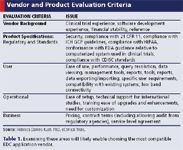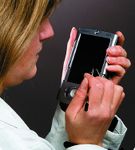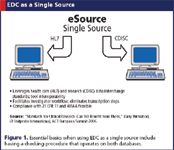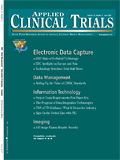EDC Progress Steady for Europe and Asia
Applied Clinical Trials
EDC is being embraced by both continents, where its efficiency is welcomed despite a few kinks.
The logic behind electronic data capture is so irresistible: eCRFs are collected via a PC connected to the Internet. But for the past two decades, EDC has suffered from a lack of global standardization, recurring difficulties at trial sites, inappropriate technology, and the conservative attitudes of many sponsors and investigators.
All the signs are that the clinical trials community is getting its act together. Most industry observers anticipate that paper-based studies will be a thing of the past within five years. During last October's Applied Clinical Trials European Summit in Amsterdam, speakers at the one-day seminar, "Embedding EDC into the Drug Development Process," provided compelling evidence about the steady, if not spectacular, progress being made in e-trials.

PHOTOGRAPHY: JIM SHIVE ILLUSTRATION: JENNIFER FOLEY
"The EDC pregnancy was a long one, and the actual EDC delivery took a very long time, but EDC is finally here," said Johann Proeve, global head of data acquisition and management at Bayer in Germany. "It will continue to develop, and hopefully it will behave, be around for a while, and make our life a little easier."
Bayer's Experience
Bayer first used remote data entry (RDE) at trial sites in 1988 and implemented RDE on a larger scale in 1991. Data were not checked for plausibility, were transmitted via diskette, and were cleaned by the sponsor. Queries were handled manually by the monitor. Obtaining a clean database was not necessarily faster than paper-based studies, and it was a cumbersome and inefficient process.
The company used various systems in Europe and the United States but introduced its global, in-house system in 2000. It selected an off-the-shelf EDC system in December 2004 and implemented a new system in September 2005. Almost all data are checked for plausibility, data are transmitted via the Internet, queries are handled by the EDC system, and little data cleaning is required by the sponsor.
"We completed the last paper-based study in July 2005. All new trials are now using EDC, and the next step is the roll out to Bayer Schering Healthcare," said Proeve. "EDC is currently the most efficient process, but there is room for improvement."
One of the problem areas is monitoring at the site level. Internet access may be restricted to hospital staff, patient files may be inaccessible in the filing room, and sites may enter information at the same time as the monitor plans to verify the source data. Furthermore, access to the server may not be available during a monitoring visit. Most data are recorded on patients' charts before being entered into the EDC system, making it difficult to avoid double data entry. Managing queries has also proven troublesome, as has follow-up reporting of serious adverse events (SAEs) due to information being added, changed or deleted, Proeve explained.
Technology is starting to have a major impact at Bayer, however. Data entry via mobile phones is proving valuable in remote areas and is already in use in South Africa. Tablet PCs for direct data entry at sites are showing promise, as are personal digital assistants (PDAs) for patient diary information. Data can also be uploaded directly from spirometers, glucometers, imaging equipment, blood pressure measurement units, and other devices. The development of standards is further simplifying the process: CDISC for data exchange and submissions, HL7 for hospital systems, and E2B data structure for adverse event reporting.
Proeve identified three other EDC trends: granting data management access to eCRFs and permit clarifications, building in as many reports as possible for data review by people other than monitors and data managers, and using metadata for identification of bottlenecks, good performers, and training needs. There is also a move toward making eCRFs smarter by showing only applicable items, increasing flexibility, and building in the release status for monitor data entry. Providing 24-hour multilingual helpdesks can help, as can greater support for trial sites when there are local Internet access problems.
The Asia-Pacific
From an EDC perspective, the Asia-Pacific region is between two and four years behind Central and Eastern Europe and Latin America, according to Graham Bunn, Medidata's vice president of strategic alliances for the EMEA. Language remains a serious issue, given the variable quality of English spoken at investigate sites. Global trials tend to be more successful if multiple languages are supported within the same database, and it is essential to view data from Chinese and Japanese sites in English, French, and German, but double-byte character sets (or triple-byte in Mandarin) stretch the capabilities of most EDC systems.
"Asia-Pacific sites have less EDC experience, but also no scars from the EDC nightmares of early technology adoption. Sites are universally keen to become involved in EDC," Bunn said. "Training must be in the local language. A one-hour English presentation at the investigator meeting is not satisfactory. Sites may need more training in 21 CFR Part 11 and local EDC-specific SOPs."
Many sites and sponsors are isolated due to the distances involved. For example, from Sydney to Tokyo is 7800 km (4800 miles), from Tokyo to Mumbai is 6750 km (4200 miles), and from Mumbai to Singapore is 3900 km (2400 miles). A common mistake is to underestimate the travel time and cost of monitoring, managing, and implementing EDC, Bunn said. While EDC plays a key role in removing distance, it remains tough to ensure data quality at sites, and the different time zones within the region can make communication difficult—India to New Zealand involves a 7.5 hour time difference.
Cultural considerations are also important. For instance, most investigators in China can read and write English, but they prefer Chinese. All source documents should be in Chinese, but recruiting a certified translator is no simple task, Bunn explained.
He advises sponsors to develop different processes and implementations in Asia-Pacific countries. From a technology standpoint, reducing complexity and maximizing flexibility are vital. Care must be taken to select the right partners, and the local knowledge of CROs can be invaluable. There are challenges, but also huge opportunities, he concluded.
Outsourcing criteria
When selecting an EDC application vendor in any part of the world, sponsors should compare the market presence, technology, track record, operation and support networks, and financial stability of at least two or three companies, said Paulo Morelli, scientific director of CROS NT in Italy. He recommends studying Rebecca Kush's vendor and product evaluation criteria (see Table 1).

Table 1. Examining these areas will likely enable choosing the most compatible EDC application vendor.
Outsourcing costs are closely related to the number of CRF pages, number of unique sections of the CRF, and number of validation checks. If errors occur after the release of the eCRF, costs can increase rapidly, so rigorous testing is necessary prior to release. The sites' hardware, connectivity, and expertise in using EDC tools also needs to be checked thoroughly. Correct use of the system from the outset will lead to less need for technical assistance and fewer monitoring visits plus a reduction in the time from visit assessment to data collection, noted Morelli.
Standardization update
There is clear evidence of the industry developing pragmatic ways to benefit from EDC standards, Barry Burnstead, director of project management at i3 Statprobe International, told delegates at the Amsterdam seminar. Some standards will receive regulatory endorsement and thereby become a requirement, and standards that offer added value and ease of use will flourish, while others may wither, he added.

"Standards are sold to our industry as the panacea. They will lead to faster regulatory approvals, facilitate ease of transfer of data, and provide a common data language for the industry to communicate," said Burnstead. "But do we have enough standards? It is important to look at the proliferation and look for a positive impact."
He recommends evaluating and/or utilizing available terminology at the outset of a trial and expanding existing terminology where incomplete, working with the vocabulary developer and owner. Terminology recommendations must be developed for all appropriate fields in the CDISC models, beginning with the study data tabulation model. Other goals are to harmonize across CDISC models and with pre-existing terminology initiatives and to ensure that terminology recommendations suit international needs for global organizations and projects.
Serious adverse events can be reported into the EDC database before they are reported to the sponsor's pharmacovigilance group, said Burnstead. This offers the potential to put clinical data management on the reporting critical path, but everybody should remember that the reporting clock starts ticking once any company representative has received notification. When using EDC as a single source (see Figure 1), it is essential to provide additional screens for investigators to report SAEs, to develop a case transfer facility from the EDC database into the safety database, and to have a checking procedure that operates on both databases.

Figure 1. Essential basics when using EDC as a single source include having a checking procedure that operates on both databases.
"Get involved and ensure that you are influencing the future direction of standards," Burnstead concluded.
Note
There will be another one-day EDC seminar on Monday October 29 at the 14th Annual Applied Clinical Trials European Summit in Berlin. For more details, please contact Patricia Mitchell pmitchell@advanstar.com or visit www.actsummit.com.
Philip Ward is the European Editor of Applied Clinical Trials, email: philipward1@btconnect.com
